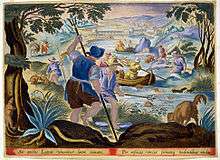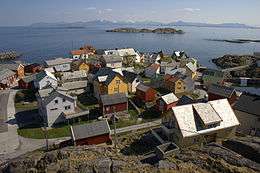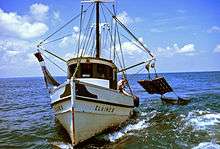Yorkshire coast fishery
The Yorkshire coast fishery has been a mainstay of the economy of the Yorkshire and Humber region for centuries. The fishing industry has been in decline since the mid to late 20th century due to many factors such as labour problems, fishing quotas and decommissioning schemes. Historically, the ports at Hull and Whitby have been important locations for the landing and processing of fish and shellfish. This industry continues today at both locations though on a smaller scale, and both have fish processing industries too. Bridlington has now become the largest shellfish port in Europe, regularly exporting its catch abroad, mostly to European countries.
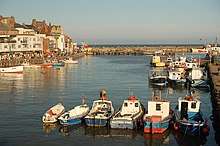 Fishing Boats Moored in Bridlington Harbour | |
| General characteristics | |
|---|---|
| Coastline | Yorkshire Coast |
| EEZ area | United Kingdom |
| Shelf area | United Kingdom |
| MPA area | Runswick Bay Holderness Inshore Holderness Offshore |
| Employment | 6,500 (2017)[note 1] |
| Landing sites | |
| Fisheries GDP | £16 million (2017) |
The ceremonial counties of the East and North Ridings of Yorkshire had many ports both small and large where sea catch was landed.[note 2]
The Yorkshire region is the second largest fishing industry in the United Kingdom (after Scotland) in terms of the number of people who work in the industry. Fish is landed commercially at four ports in Yorkshire; Bridlington, Hull, Scarborough and Whitby
History
Up until the 1840s, the fisheries were landing catches that supplied only their immediate area;[3] Scarborough, for example, saw an increase in its fishing fleet from 130 ships in 1840 to 800 ships in 1860. The rise in the number of boats and the increased catch, was down to the coming of the railways, which allowed fresh fish to be transported many miles inland.[4] The transport of fish was an important business for the railways, and in 1922, the tonnages of fish transported by the railway network from the Yorkshire ports was as follows;
| Station name | Tonnage | Totals | Notes |
|---|---|---|---|
| Staithes | 203 tonnes (224 tons) | 203 tonnes (224 tons) | [5] Small tonnages were usually sent in vans attached to passenger trains, which were then shunted onto larger freight trains in Whitby or Scarborough[6] |
| Whitby | 182 tonnes (201 tons) | 385 tonnes (424 tons) | [7] |
| Scarborough | 7,791 tonnes (8,588 tons) | 8,176 tonnes (9,012 tons) | Most of the fish traffic was loaded at Gallows Close goods yard[8] |
| Filey | 164 tonnes (181 tons) | 8,340 tonnes (9,190 tons) | [9] |
| Flamborough | 386 tonnes (425 tons) | 8,726 tonnes (9,619 tons) | [9] |
| Bridlington | 310 tonnes (340 tons) | 9,036 tonnes (9,960 tons) | [10] |
| Hull Paragon | 86,910 tonnes (95,800 tons) | 95,946 tonnes (105,762 tons) | [11] |
The forwarding of fish from Hull also meant that it developed a lucrative fish market with buyers from many inland places needing their catch taken inland as it was a perishable commodity.[12]
Some of the first experiments in deep-sea trawling were conducted off the Holderness Coast at Flamborough in the early part of the 19th century.[13] However, until the days of large fishing trawlers in the 20th century, the most common boat in service across Yorkshire (and the north east coast) was the Coble. The design of the coble is a basic one with a short plank laid horizontally instead of a keel and a flat bottom on the boat. The flat bottom allowed the coble to be berthed almost anywhere as it did not need extensive harbour facilities; most cobles where simply hauled onto the beaches when not in use.[14]
The coble (pronounced cobble) has been on the eastern coast of Britain for a 1,000 years[15] and has a ribbed look (known as clinker built) where the planks, made from larch wood, overlap each other.[16][17] The coble fell out of favour after the First World War as they were sail boats, and motorised fishing vessels took their place,[18] although some cobles have had engines fitted.[19] There are now several preservation movements dedicated to the history of the coble.[20][21]
One tradition that still exists is that of the Gansey.[22] These are woollen jumpers that fishermen wore whilst at sea to keep them warm and deflect sea spray. The tradition in the Yorkshire ports was that each one had a different design. This was practical rather than sartorial; if a body of a fisherman was washed ashore his port of origin could be easily identified.[23]
The port of Whitby was noted as being the main port for the landing of herring. The herring fishery extended from 3 miles (4.8 km) to 7 miles (11 km) east of Whitby, though some boats went fishing as far out as 60 miles (97 km).[24] Not all of the boats came from Whitby, or indeed from Yorkshire; fishing boats came from as far afield as Scotland, East Anglia and Cornwall.[25] Whitby still has a traditional kipper smokehouse, though most of the herring comes from Norwegian waters.[26] As a side venture to the herring fishery, sport fishing for tuna was carried out until the early 1950s, when the tuna stopped coming due to the overfishing of herring and mackerel.[27]
The inherent danger of fishing at sea is borne out by the fact that between 1808 and 1970, over 400 ships were lost off the Yorkshire coast. At least 74 of these (19%) were lost due to military action during the First and Second World War's.[note 3] Many fishing vessels were lost after the First World War when their nets brought sea mines onto the ship; in 1919, three Hull trawlers were lost this way, similarly, three trawlers working out of Scarborough were lost in 1920, one of which went down with all hands.[30]
Throughout the 1960s, the crab fishery on the Yorkshire coast represented 40% of the catch landed in England and Wales.[31] Cobles landed the catch at Redcar, Staithes, Whitby, Scarborough, Filey, Flamborough and Bridlington.[32]
The fishermen who worked out of the Port of Hull suffered during the Cod Wars of the 1960s and 1970s. Trawlermen who lost their jobs as a result of the agreement between the United Kingdom and Iceland did not receive redundancy payments, though some were entitled to compensation after an intervention by Alan Johnson MP.[33] Fishermen working out of Hull (and Grimsby) were given incentives such as being partners in the boats they operated on which regulated supply of fish and kept the market price of the commodity stable. However, this in turn led to the smaller ports landing less fish as the buyers went to either Hull or Grimsby to obtain fish on a regular basis because of the guaranteed supply.[34]
Due to overfishing, a European scheme to curtail the amount of fish landed led to a decommissioning scheme throughout the 1990s and into the early part of the 21st century.[35] Fishermen and women were encouraged to scrap their boats and forfeit their licences in return for a government grant to compensate them.[36] Money awarded to applicants fluctuated with demand and specific food fish (at times, only the whitefish boats were needed to sign up for the scheme.)[37] In 2001, the UK Government were paying £1,684 per gross tonne of vessel.[38]

By the start of the 21st century, the fishing industry in Yorkshire was using five main methods of catching fish;[39]
- Potting
- Gill netting
- Trawling
- Scallop dredging
- Intertidal netting.
On the section of the Yorkshire coast between Flamborough Head and Spurn Point (the Holderness Coast), the fishery now only lands crab and lobster.[40]
After the public vote for Brexit, a government sponsored report stated that over 6,500 people throughout Yorkshire were directly involved in the fishing industry. This placed the Yorkshire and Humber region as second only in size to Scotland, which is the largest fishing industry sector in the United Kingdom.[1] Additionally, the post-Brexit scenario could include fishing fleets operating from Yorkshire ports being denied the rights to fish in waters off of Norway and Iceland.[41]
Commercially, fish is landed at only four Yorkshire ports (Bridlington, Hull, Scarborough and Whitby) though not all fish landed at these ports are from fleets registered at those ports. Additionally, the port at Whitby has suffered from a lack of investment in its infrastructure, so much so, that some fishing boats registered at Whitby travel to the dock at North Shields, 50 miles (80 km) to the north to unload their catch.[42] Even so, the catch landed in Yorkshire represented a value of over £16 million in 2017.[43]
Whitby has the only fishing school in the United Kingdom, which aims to afford training to young apprentices in the various fishing trades on offer around the coasts of Britain.[44]
Ports
During the 18th, 19th and 20th centuries, the following locations were known as having fishing boats working from them.[45] These are listed from north to south;[46]
| Name | Extant | Fishery type | Approx no. boats | Fish landed | Period | Notes | Ref |
|---|---|---|---|---|---|---|---|
| South Gare | Yes | Small-scale | Ten | Codling, plaice, sole turbot, eels | Seasonal | [47] | |
| Coatham | No | Small-scale | |||||
| Redcar | Yes | Small-scale | Eleven (five full-time) | Cod, whiting, plaice, sole, turbot, crab, lobster | Year round | [47] | |
| Marske | Yes | Small-scale | Three (one full-time) | Crab and lobster | Year round | [47] | |
| Saltburn | Yes | Small-scale | One | Cod, flatfish, lobster, crab | Year round | [48] | |
| Skinningrove | Yes | Small-scale | Four | Whitefish, lobster, salmon, sea trout | Year round | [47] | |
| Staithes | Yes | Small-scale | Four | Cod, sole, plaice, codling, lobster, crab | Year round | [49] | |
| Port Mulgrave | Yes | Small-scale | Two | Crab, lobster | Summer only | [49] | |
| Runswick Bay | Yes | Small-scale | Two | Flatfish and shellfish | Year round | [49] | |
| Sandsend | Yes | Small-scale | Two | Crab, lobster | Spring to Autumn | [49] | |
| Whitby | Yes | Commercial | Twenty | cod, haddock, whiting, plaice, lemon sole, sole, rays, dogfish, nephrops, red mullet, saithe, sea bass, pollack, conger eel, brown crab, velvet crab, lobster, salmon, sea trout, mussel, squid | Year round | Whitby also has visiting boats from outside the Yorkshire Area | [49] |
| Robin Hood's Bay | Yes | Small-scale | Five | Cod, crab, lobster | Seasonal | [49] | |
| Scarborough | Yes | Commercial | Twenty-nine | Cod, haddock, whiting, lemon sole, plaice, ray, Dover sole, codling, queen scallop, crab, lobster | Year round | Scottish vessels catching shellfish also land their catch in Scarborough | [50] |
| Filey | Yes | Small-scale | Five | Cod, lobster, sea trout, sole | Year round | Fish are generally landed from autumn to spring, with lobster fished during the summer | [51] |
| Flamborough | Yes | Small-scale | Six | Cod, ling, pollack, sea bass, lobster | Year round | As at Filey, the catch changes with the time of year with three boats at the North landing and three at the South landing | [51] |
| Bridlington | Yes | Commercial | Thirty-eight | Shellfish, cod, sole, sea bass, plaice, turbot, sea trout, salmon | Year round | No boats are based in Bridlington, but nearly 40 boats land their catch there | [51] |
| Barmston | No | Small-scale | |||||
| Hornsea | Yes | Small-scale | Eight | Sole, cod, whiting, crab, lobster | Year round | [51] | |
| Aldborough | No | Small-scale | |||||
| Tunstall and Withernsea | Yes | Small scale | Fifteen | Crab, lobster, cod | Year round | Boats also fish in Withernsea, and the two ports are interchangeable | [51] |
| Patrington | No | Small-scale | |||||
| Easington | No | Small-scale | |||||
| Kilnsea, Spurn Point and Stone Creek | Yes | Small-scale | One (some seasonal) | Cod, flatfish, crab, lobster | Year round | [51] | |
| Paull | No | Small-scale | |||||
| Hull | Yes | Commercial | Eleven | Cod, haddock, crab, brown shrimp, dab, sole, plaice, flounder, eel | Year round | Whitefish is still an important industry in Hull, with most catch being landed at the port already frozen | [52] |
Those shown in bold, still land fish commercially in the 21st century.
Detailed history of ports
- Coatham
The name Coatham derives from cot-ham, a sheltered homestead.[53] It is believed that boats could rest up at Coatham when the weather was bad. Some fishing activity was engaged in here and it was a market town since 1257 compared to the tiny fishing village of Redcar. Both Redcar and Coatham are a contiguous urban area now.[54]
- Redcar
The fishing industry at Redcar started in the early 14th century. Fishing has been mostly crab and lobster, though during the 20th century, the numbers of boats has been in decline.[55] Line fishing for cod was also undertaken sporadically, but the fishery was largely an inshore concern and the local fishermen say that the cod gave gone further north for colder waters.[56]
- Saltburn
Saltburn was always a low-key fishing endeavour as it was largely a new town created in the 19th century in an effort led by Henry Pease.[57] The settlement came under the Parish of Marske and was developed as a new resort in the 1860s, therefore it does not have the same centuries-old fishing histories such as Redcar, Whitby or Robin Hood's Bay.[58] It still has a small-scale fishing operation.
- Skinningrove
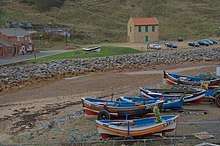
Skiningrove had been an important fishing centre since Medieval times. The arrival of the ironstone industry in the village, and along the Cleveland coast, led to many fishermen abandoning their boats for work in the mines.[59][60]
- Staithes
The fishermen who worked out of Staithes used line fishing and would not fish on Sundays for religious reasons. In the 1860s when large trawler fleets from Scarborough, Hull and France threatened fish stocks, many fishermen took jobs in the steel and mining industries. By the end of the 19th century, almost of the population of the village relied on the fishing industry. At least forty-two cobles and fourteen smacks were listed as fishing from Staithes in the 1890s.[61] By the 1950s, only three boats were working out of Staithes. Government incentives persuaded people to go out fishing again, and by 1972, Staithes was listed as being the tenth highest port for the tonnage of lobster it was landing.[62]
- Port Mulgrave
The port here was not built until 1857 and was initially used to export ironstone from the hills nearby to smelters on the River Tyne. It still supports a small number of fishing cobles who fish for lobster and crab mostly. Part of the dynamiting of the coast to the north was undertaken to allow ships to sail right up to the cliff edge to load ironstone. This has created tanks with seawater in that were used by fishermen to store live lobsters.[63][64] The fishing is seasonal and typically has less than six boats working from the harbour.[65]
- Runswick Bay
Runswick Bay was a "traditional, ancient fishing village", though the village is now known as a tourist destination and a location for collecting fossils. Some sea-fishing takes place from here, but in smaller numbers than back in the 18th and 19th centuries,[66][67][68] when the village had around 20 cables sailing from the harbour.[69]
- Whitby
Accounts of Whitby maintained by the monks at Whitby Abbey show that the port was trading in fish as far back as 1394.[70][71] However, in the 12th century, the Abbott in charge at Whitby Abbey was in a dispute with the prior of Bridlington regarding the tithes being applied to the fishermen along the coast.[72]
Whilst strictly not fishing for food, the significance of the port of Whitby as a whaling centre cannot be ignored. Oil and fat from whales had many uses before synthetic and natural substances came available.[73] However, whale oil and fat were usually imported into Britain from countries that the British were quite often engaged in open warfare with at that time, such as France and Spain.[74]
Given the long time dedicated to food fishing, the whaling industry had a short time span. The first ships left Whitby in 1752,[75] whereas the last whaling ship set sail from Whitby for Greenland (where the whaling seas were to be found) in 1837.[76] During this time, Whitby is said to have dispatched over 25,000 seals and 2,761 whales.[77]
Whitby is now one of two ports along the Yorkshire coast to have a seafood processing plant.[78]
In 2016, the catch landed at Whitby totalled 715 tonnes (788 tons) with a value of £2.1 million,[79] but was home to just one trawler, with most fishing being close to shore for crustaceans. In the 1990s, Whitby had 25 trawlers registered to her harbour.[80]
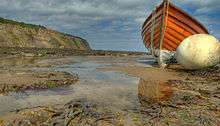
A third type of fishing at Whitby occurred slightly inland, but involved the catching of sea going fish. Traps were set along the River Esk, even as far upstream as Ruswarp, so that salmon and sea tout could be caught. This practice is recorded as far back as 1200.[81]
- Robin Hood's Bay
In 1530, Robin Hood's Bay was referred to as a "Fisher townlet of twenty boats".[72] At that time, it was known to be an important fishing location,[82] with some attaching a greater importance to Robin Hood's Bay than Whitby during the 16th century. Records show that the catch landed at Robin Hood's Bay during these times was larger than at Whitby or Scarborough.[83] Smuggling overtook fishing as the main industry in the village by the 18th century; this has been attributed to its relative isolation as it was surrounded on three sides by marshy moorland.[84] Even so, in 1816, Whitby had nine fishermen and three fishmongers, Scarborough had three large fishing boats, whereas Robin Hoods Bay had 35 cables and over 130 fishermen.[85]
- Scarborough
In 1252, an edict passed by Henry III dictated the levies taxed against boats entering Scarborough Harbour. Thus was between four and sixpence for fishermen depending on the size of the boat.[86] Fish land at Scarborough included cod, halibut, ling, turbot, skate, lobster, crab, shrimp, mackerel, sole, dab, plaice, herring, gurnard Whiting, coalfish and haddock.[87] But by far the greatest importance was placed upon the herring. It was such a great part of the fishing economy despite the season only lasting for August and September.[88] However, the landings were good; in the 1870s, this amounted to such a large tonnage that an express fish train to London left Scarborough daily.[89]
- Filey
Exports from Filey were historically greater than that of Hull; it was only down to the latter's railway and dock expansion that its exports overtook those of Filey. Of particular importance were skate wings and other dried fish which were in demand in Portugal especially, but also in France.[90]
As in most fishing villages, the women folk of Filey were involved in the fishing industry. Known as Flither Girls, women would scour the coastline looking for limpets which the fishermen would use as bait for catching fish such as herring. Flither is a local term for limpet.[91][92] In the 1960s, eleven boats were working out of the shoreline to fish for crab and lobster.[93] Filey has suffered a downtown in the 21st century, with many boats leaving for Scarborough to work from.[94] The fishermen at Filey now fish only between April and August and whilst sea trout is an accepted catch, salmon must not be caught or landed.[95]
- Flamborough
Fishing out of North Landing at Flamborough can be traced as far back as the 13th century, and like many other locations on the east coast, it utilised cobles.[96] In the 1960s, ten boats were based out of Flamborough primarily engaged in fishing for crab and lobster.[93] In the 21st century, this had been reduced to six boats.[51]
- Bridlington
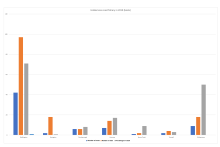
Fishing from Bridlington goes back centuries, although official records detailing registered vessels only extend as far back as 1786.[18]
Bridlington is now the leading shellfish port in Europe, landing over 420 tonnes (460 tons) in 2014, which had risen to 539 tonnes (594 tons), with a value of £1.6 million by 2018.[97] Most of the lobsters and other shellfish landed at Bridlington are exported, mainly to France, Spain and Portugal.[98][99] In 2017, work started on a lobster hatchery in the port of Bridlington for the purposes of research into the species.[100]
In 2011, the Holderness shellfish industry was estimated to have 145 people employed across 66 boats. The value of the shellfish catch across Holderness was £6 million.[101]
- Hornsea
Fishing in Hornsea was largely concentrated on the Mere form as early as the 13th century.[102] However, a seaborne trade in fishing (and other goods) flourished from the 16th century onwards, with cobles being launched from the beck that drained the mere into the sea.[103] In 2009, the fishery landed over 320 tonnes (350 tons) of mailnt shellfish.[104]
- Withernsea
Like Saltburn, Withernsea does not have a long-standing history of fishing. The landing of fish in the town was hoped to be increased when the railway arrived in Withernsea, however, the location of the town was so near to the Port of Hull, that most boats could land their catch there instead.[105] Fishing is still continued on a small basis, which land shellfish and flatfish, with a small sideline in intertidal netting for sea-trout.[106]
- Humber fisheries
The lost village of Ravenser Odd was noted for its herring industry as far back as 1360. Herring landed at Ravneser Odd was traded throughout Europe and attracted many fish merchants from across England to its sales.[107]
During the 18th and 19th centuries, fishermen working out of Patrington and Paull, fished the Humber Estuary for prawns and shrimp which were then sold in the local area.[108] Shrimp fishing was still taking place in the Humber Estuary well into the 1990s when special trawls were undertaken in the autumn months.[109]
- Kingston upon Hull
Hull was recognised as one of the great fishing towns of the world and what one writer described as being the "vanguard of innovative developments in the industry for much of this [the 20th] century".[3] Before the Cod Wars, Hull was the third largest port in Britain for fish landings.[110] A much reduced trawler fleet still calls Hull home, but as the vessels they operate are up to 230 feet (70 m) in length and are true trawlers, they tend to fish in deeper waters away from the Yorkshire Coast (in the seas off the Faroe Islands, Greenland, Iceland and Norway).[111]
Shipbuilding
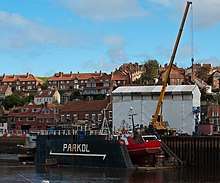
Besides fishing, a secondary business involved shipbuilding, some of the most notable were;
- Cook, Welton & Gemmell – who had a shipbuilding yard on the River Hull at Beverley,[112] and another on the estuary at Hull where The Deep now stands. they traded from 1883 to 1963 at Beverley, though the demand for heavier ships could not be accommodated at Beverley which was 9 miles (14 km) upstream on the River Hull.[113][114]
- Cochrane Shipbuilders – founded in Selby in 1884, the yard became Cohrane's & Sons, before changing hands many times during the second half of the twentieth century. The yard was closed in 1992 and all the equipment was auctioned off in 1993.[115]
- Tony Goodall – Goodall worked at Sandsend between 1953 and 1995 where he built cobles for the local fishing industry.[116]
- Goole Shipbuilding and Repairing Company – built mostly larger ocean going transport vessels or ships for the Royal Navy. Also built some of the larger trawlers for use in UK waters.[117]
- Parkol Marine Engineering – one of a small number of extant shipbuilders in Britain who build fishing boats. The company are based in Whitby,[118] with another build plant on Teesside.[119]
- Pickersgill & Sons - based in Thornaby-on-Tees, the firm ceased boatbuilding in the 1960s.[120]
Many more detailed descriptions are contained in the Ship and boat building in Whitby article.
Registration of boats

Boats are given registration letters for the port they are allocated to. In Yorkshire, the codes are;
- GE = Goole
- H = (Kingston upon) Hull
- MH = Middlesbrough
- SH = Scarbrough
- WY = Whitby.[122]
Many of the boats registered to Hornsea and Withernsea have a GY code, which is for Grimsby. Some boats which are registered to one of the Yorkshire home ports, may have codes for outside the Yorkshire region, such as Stornoway or Fowey. A sample of the number of boats and their registrations for 1967 and 2020 is given below. In 2020, vessels are registered as being either under, or over 10 metres (33 ft), with the Marine Management Organisation (MMO).[121][123]
| Port | > 40 ft boats 1967 | < 40 ft boats 1967 | > 33 ft boats 2020 | < 33 ft boats 2020 | Notes |
|---|---|---|---|---|---|
| Redcar | 3 | 0 | 27 | 0 | All 2020 boats are registered in North Shields (SN), but most have a Middlesbrough (MH) code |
| Staithes | 5 | 0 | 4 | 0 | All boats are registered in Scarborough, though some have been registered in Hartlepool (HL)[125] |
| Whitby | 14 | 13 | 28 | 9 | Whilst Whitby has its own code (WY), all boats are registered in Scarborough |
| Scarborough | 25 | 2 | 24 | 11 | One boat is registered to Fleetwood |
| Filey | 11 | 0 | 1 | 0 | All boats are registered in Scarborough |
| Flamborough | 10 | 0 | 4 | 0 | All boats are registered in Scarborough |
| Bridlington | 7 | 8 | 17 | 23 | All boats are registered in Scarborough bar one, which is registered in Campbelltown |
| Hornsea | ♦ | ♦ | 19 | 0 | All boats are registered in Grimsby |
| Withernsea | ♦ | ♦ | 12 | 0 | All boats are registered in Grimsby |
| Hull | ♦ | ♦ | 0 | 10 | Whilst Hull has its own registration (H), all boats are registered in Grimsby |
♦ Means that data is not available
Culture
The feature film Turn of the Tide was filmed in and around Whitby and Robin Hood's Bay.[126] The story revolves around the rivalry between two fishing families and features the Bay Hotel in Robin Hood's Bay.[127] Disappointed by the take up for his first film, J Arthur Rank started his own distribution company to market the film properly.[128]
Bridlington holds a sea food festival sporadically (2011, 2016, 2019), to emphasise the importance of being the largest shellfish port in Europe.[129]
Filey is host to the Filey Fishermen's Choir who trace their origins back to 1823.[130]
In May 2019, Whitby held its first Fish & Ships festival which celebrated the stories and history of fishing at sea.[131]
Museums and historical
Starting in 1989, every January or February, there is a Lost Trawlermen's Memorial Day held at St Andrew's Dock in Hull. The service remembers the 6,000 men who died at sea whilst engaged in fishing. The number of dead only accounts for those lost at sea who sailed from Hull and the time of year is intended as that was hen most ships were lost.[132]
- The Arctic Corsair – a floating museum on the River Hull in Kingston upon Hull. The Arctic Corsair was traditionally a side winder trawler that was active during the Cod Wars.[133]
- Bridlington Maritime Trail - a walk around the harbour and south side of Bridlington[134]
- Hull Fish Trail – a walk around Hull with 41 sculptures of life sized fish.[135]
- The Viola – a trawler built in Beverley and used in the North Sea fishing fleet from Hull until requisitioned by the Royal Navy in the First World War. She is in a derelict condition at Grytviken on South Georgia, although efforts continue to return the vessel to Hull as a permanent showpiece.[136][137]
Accidents and incidents
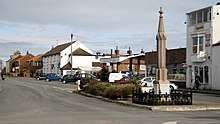
- 5 February 1909 – A fleet of 40 or 50 cobles were fishing in the bay off the North Landing when a gale "whipped the sea up into mountainous waves". The three occupants of one boat, Gleaner, found themselves washed overboard and another boat the Two Brothers, stopped to help the stricken men. The one boat with six men was then upturned by another rogue wave and all six drowned within sight of the shore and beyond the reach of the lifeboat.[138] A memorial was later installed in the village to commemorate the dead.[139]
- 9 January 1935 – The trawler, The Edgar Wallace, was coming into port at St Andrews Dock in Hull, when it hit a sandbank and capsized. Water rushed into the cabins and 15 members of her crew drowned, with the three survivors swept overboard, but being rescued by passing ships.[140]
- 25–26 January 1955 – the trawlers Lorella and Rodrigo were in a safe haven off Iceland, sitting out a ferocious storm. Another trawler, the Kingston Garnet, was nearby with her propeller fast on some wire in the sea. Both the Lorella and the Rodrigo left what was described as "[a] comfy place, but they went back into that living hell to try and save those guys." Both ships foundered when ocean spray froze instantly on the rigging, normally 0.5 inches (13 mm) thick, but swelling to 7 inches (180 mm) thick with the frozen water. Both ships rolled over and up until the last minute, they were still radioing what was happening. 40 men lost their lives in the sinking; no bodies were found.[141] Both ships were lost 90 nautical miles (170 km; 100 mi) off of Icelands' North East Cape.[142][143]
- Arctic Viking (1961)
- Hull triple trawler tragedy (1968)
- FV Gaul (1974)
- October 1976 – The trawler Admiral Von Tromp set out from the port of Scarborough with her destination being the Barnacle Banks some 45 nautical miles (83 km; 52 mi) north east of Scarborough. Somehow she ended up stranded on Saltwick Nab some 90 degrees off course. the man at the wheel and one other deckhand drowned that night, the others were rescued by the Whitby Lifeboat or washed ashore. At the inquest into the sinking, a nautical expert claimed that even if the ship had been left to her own devices, she would not have foundered on Saltwick Nab. The inquest concluded that the wheelman had piloted the vessel onto the rocks deliberately.[144]
See also
Notes
- Official designation is Yorkshire and the Humber, so statistics will include the town of Grimsby.[1]
- The traditional definition of the Yorkshire region is the 114 miles (183 km) of coastline between the mouth of the River Tees and the Humber Estuary.[2] As such, the sea fishing industry was confined to the East and North Ridings of Yorkshire, though catches could be landed in Goole which was historically in the West Riding. Post 1974, some of the ports along the coast around Redcar are now classified as being in Redcar and Cleveland.
- Fishing boats as casualties of both world wars were lost by being struck by torpedoes, engaged by enemy aircraft, attacked deliberately by U-Boats, or sunk after hitting mines.[28][29]
References
- Ares, Elena; Rhodes, Chris; Ward, Matthew (December 2017). "The UK Fishing Industry" (PDF). researchbriefings.files.parliament.uk. p. 5. Retrieved 16 February 2020.
- Mitchell, Barry (1984). "Introduction". Exploring the Yorkshire coast (4 ed.). Clapham: Dalesman. p. 5. ISBN 0-85206-764-X.
- Uglow 1991, p. 180.
- "Scarborough Maritime Heritage Centre | History of the Scarborough Fishing Industry". www.scarboroughsmaritimeheritage.org.uk. Retrieved 27 July 2019.
- Hoole 1985, p. 190.
- Hoole, K (1983). Railways of the North York Moors : a pictorial history. Clapham: Dalesman Books. p. 55. ISBN 0852067313.
- Hoole 1985, p. 196.
- Hoole 1985, p. 186.
- Hoole 1985, p. 164.
- Hoole 1985, p. 155.
- Hoole 1985, p. 171.
- Finn, M W (1975). "9: Transport". Economic and Social History of Britain Since 1700. London: Macmillan Publishers Limited. p. 109. ISBN 978-1-349-00025-8.
- HCF 2011, p. 12.
- Allen, Irene; Todd, Alan (1985). Filey : a Yorkshire fishing town : Filey fishing families over the last two centuries. Allen & Todd. p. 24. ISBN 0-948781-00-9.
- "Antique coble gets face lift". BBC News. 26 August 2009. Retrieved 4 August 2019.
- "Reviving the ancient skill of coble-building". The Yorkshire Post. 7 July 2014. Retrieved 4 August 2019.
- "Scarborough Maritime Heritage Centre | Yorkshire's last traditional sailing fishing coble". www.scarboroughsmaritimeheritage.org.uk. Retrieved 4 August 2019.
- "Archive cobles together boating heritage pictures". Bridlington Free Press. 11 August 2016. Retrieved 4 August 2019.
- "Return of the 'little ships' that brought fish back to Bridlington". The Yorkshire Post. 18 April 2019. Retrieved 4 August 2019.
- "Cobles to descend on harbour for festival". Bridlington Free Press. 1 April 2016. Retrieved 4 August 2019.
- "Name Three Brothers | National Historic Ships". www.nationalhistoricships.org.uk. Retrieved 4 August 2019.
- "What's a gansey?". www.bbc.co.uk. Retrieved 3 December 2019.
- Freeman, Sarah (10 March 2018). "How one Robin Hood's Bay firm is knitting a future in heritage fishing jumpers". The Yorkshire Post. Retrieved 16 August 2019.
- "England's Historic Seascapes: Scarborough to Hartlepool". Archaeology Data Service. Retrieved 27 July 2019.
- "Point 5 - The fish quay". www.bbc.co.uk. Retrieved 3 December 2019.
- "We visited Whitby's last traditional kipper smokehouse". The Yorkshire Post. 2 February 2019. Retrieved 3 December 2019.
- "Coble in rare tuna catch off Whitby". The Yorkshire Post. 23 June 2012. Retrieved 3 December 2019.
- Godfrey 1974, pp. 61–71.
- Airey, Tom (30 September 2016). "The 'gentlemanly massacre' of WW1 ships". BBC News. Retrieved 17 October 2019.
- Robinson, Robb (2019). "8: The Aftermath". Fishermen, the fishing industry and the Great War at sea : a forgotten history?. Liverpool: Liverpool University Press. pp. 170–171. ISBN 978-1-78694-175-6.
- Edwards 1967, p. 1.
- Edwards 1967, p. 10.
- Ledger, John (21 December 2015). "How the Cod War of 40 years ago left a Yorkshire community devastated". The Yorkshire Post. Retrieved 27 July 2019.
- Uglow 1991, p. 181.
- Hatcher, Aaron C (November 1997). "Producers' organizations and devolved fisheries management in the United Kingdom: Collective and individual quota systems". Marine Policy. 21 (6): 519–533. doi:10.1016/S0308-597X(97)00019-5.
- Kravanja, Milan; Shapiro, Ellen (1993). World fishing fleets : an analysis of distant-water fleet operations, past, present, future. Vol. V, The Baltic States, the Commonwealth of Independent States, Eastern Europe. Silver Spring: National Marine Fisheries Service, National Oceanic and Atmospheric Administration. p. 159. OCLC 31596945.
- "Fishing pay-off scheme opens". BBC News. 31 August 2001. Retrieved 17 February 2020.
- "Trawlers set to be scrapped in fishing scheme". The Yorkshire Post. 12 December 2001. Retrieved 17 February 2020.
- "Yorkshire's fishing industry today". North York Moors National Park. Retrieved 26 July 2019.
- "Cash awarded for fishing industry". BBC News. 25 November 2011. Retrieved 26 July 2019.
- "State-of-the-art Hull trawler could end up on quayside in event of no deal". The Yorkshire Post. 9 September 2019. Retrieved 9 September 2019.
- "Fishermen move north for profit". BBC News. 27 April 2011. Retrieved 1 January 2020.
- "Shellfish catches lead the way for Yorkshire harbours". Fishing News. 29 July 2017. Retrieved 1 January 2020.
- Carr, Flora (10 October 2017). "How a local school in Whitby hopes to save Britain's fishing industry". The Telegraph. Retrieved 1 January 2020.
- Freethy 2012, p. 4.
- Lewis, Stephen (19 November 2012). "Memories of the Yorkshire fishing industry". York Press.
- Walmsley & Pawson 2007, p. 17.
- "Saltburn Conservation Area Management Plan" (PDF). redcar-cleveland.gov.uk. October 2019. p. 25. Retrieved 7 January 2020.
- Walmsley & Pawson 2007, p. 18.
- Walmsley & Pawson 2007, p. 18–19.
- Walmsley & Pawson 2007, p. 19.
- Walmsley & Pawson 2007, p. 19–20.
- Ekwall, Eilert (1960). The concise Oxford dictionary of English place-names (4 ed.). Oxford: Oxford University Press. p. 124. ISBN 0-19-869103-3.
- "History of Redcar". thisisredcar.co.uk. Retrieved 29 September 2019.
- Forsyth, Ian (12 February 2016). "Redcar's inshore fishing fleet – in pictures". The Guardian. Retrieved 29 September 2019.
- "Seaside town of Redcar boasts Yorkshire's most unsung piece of history". The Yorkshire Post. 15 August 2018. Retrieved 29 September 2019.
- Dowle, Jayne (8 June 2007). "Bargain boltholes in Saltburn by the Sea". The TImes. Retrieved 16 February 2020.
- "Genuki: Marske By The Sea, Yorkshire (North Riding)". www.genuki.org.uk. Retrieved 16 February 2020.
- Skinningrove village trail. Guisborough: Guisborough Educational Development Centre. p. 1. OCLC 654902228.
- Smith, Jonathan (23 August 2019). "Classic undulations by the coast". Darlington & Stockton Times (34–2019). p. 59. ISSN 2516-5348.
- Shaw, Michael, ed. (1990). Frank Meadow Sutcliffe, Hon. F.R.P.S. : Whitby and its people as seen by one of the founders of the naturalistic movement in photography : a third selection of his work. Whitby: Sutcliffe Gallery. p. 42. ISBN 0-9503175-6-X.
- Wilson 2013, pp. 14–16.
- "Trawling for fresh business". The Yorkshire Hub. 30 June 2009. Retrieved 22 August 2019.
- Walker, Peter (6 February 2013). "Tiny Mulgrave is not any old port in a storm". Gazette & Herald. Retrieved 22 August 2019.
- Gray 1995, p. 25.
- Swift, Nina (22 March 2018). "£1.5m plan to protect homes in North Yorkshire fishing village threatened by landslips". The Yorkshire Post. Retrieved 14 October 2019.
- "Scarborough Maritime Heritage Centre | Runswick Bay superstitions - caves and a landslip". www.scarboroughsmaritimeheritage.org.uk. Retrieved 14 October 2019.
- "Runswick Bay | Marine Conservation Society". www.mcsuk.org. Retrieved 14 October 2019.
- "Runswick Bay comes into its own after summer visitors leave". York Press. 1 September 2011. Retrieved 14 October 2019.
- Tindale 1987, p. 9.
- Barker, Rosalin (2003). Butlin, Robin (ed.). Historical atlas of North Yorkshire. Otley: Westbury. p. 211. ISBN 1-84103-023-6.
- Hall 2013, p. 10.
- Tindale 1987, p. 20.
- "Scarborough Maritime Heritage Centre | History of the Whitby whaling industry". www.scarboroughsmaritimeheritage.org.uk. Retrieved 3 August 2019.
- Hall 2013, p. 12.
- "Nostalgia: Fearless Whitby whalers". The Scarborough News. 3 April 2018. Retrieved 3 August 2019.
- Hirst, Christopher (4 February 2012). "On the waterfront: Frank Meadow Sutcliffe's Whitby". The Independent. Retrieved 13 August 2019.
- "Stable raw material prices help boost profit at Whitby Seafoods". The Yorkshire Post. 18 August 2014. Retrieved 3 August 2019.
- "Shellfish catches lead the way for Yorkshire harbours". Fishing News. 29 July 2017. Retrieved 16 August 2019.
- Bounds, Andrew (21 July 2016). "Crumbling harbour walls tell Whitby's tale". Financial Times. Retrieved 18 October 2019.
- Tindale 1987, p. 68.
- "History of Robin Hoods Bay, in Scarborough and North Riding | Map and description". www.visionofbritain.org.uk. Retrieved 16 August 2019.
- Freethy 2012, p. 24.
- Lloyd, Chris (27 September 2019). "Looking Back". Darlington & Stockton Times (39–2019). p. 54. ISSN 2516-5348.
- Dalton, William (1909). Guide to Robin Hood's Bay and District. Robin Hood's Bay: Dalton. p. 17. OCLC 558760365.
- Coggins 1991, p. 97.
- Coggins 1991, p. 105.
- Coggins 1991, p. 108.
- Fawcett, Bill (1995). A history of the York-Scarborough Railway. Cherry Burton: Hutton Press. p. 61. ISBN 1-872167-71-3.
- Freethy 2012, p. 43.
- Freeman, Sarah (7 September 2005). "Tales of the limpet girls who stuck to their task". The Yorkshire Post. Retrieved 19 August 2019.
- Freethy 2012, p. 45.
- Edwards 1967, p. 4.
- "FISH INDUSTRY ON THE VERGE OF COLLAPSE". The Filey Mercury. 23 April 2011. Retrieved 1 January 2020.
- Warner, Mike (3 March 2018). "Why Filey's fishermen fear they may be the last generation to cast their nets". The Yorkshire Post. Retrieved 1 January 2020.
- "Flamborough Head". www.flamboroughheadsac.org.uk. Retrieved 1 January 2020.
- "Provisional Results Monthly UK Sea Fisheries Statistics - Reported Landings: December 2018" (PDF). assets.publishing.service.gov.uk. February 2019. pp. 1–2. Retrieved 1 January 2020.
- Grainger, John (13 September 2016). "Why Bridlington is the lobster capital of Europe". The Yorkshire Post. Retrieved 3 August 2019.
- "East Yorkshire Coast - The Holderness Coast Fishery". www.eastyorkshirecoast.com. Retrieved 3 August 2019.
- "Bridlington (Lobster Hatchery and Research Facility) 2019 | West of Morecambe Fisheries". westofmorecambe.com. Retrieved 31 January 2020.
- "Shellfishermen net £1m boost to help develop top UK fishery". The Yorkshire Post. 28 November 2011. Retrieved 31 January 2020.
- Robinson, Robb. "East Yorkshire Coast - A History of Fishing in East Yorkshire". www.eastyorkshirecoast.com. Retrieved 16 February 2020.
- "North division: Hornsea | British History Online". www.british-history.ac.uk. Retrieved 16 February 2020.
- HCF 2011, p. 13.
- "East Yorkshire Coast - The Fishing Heritage of Withernsea". www.eastyorkshirecoast.com. Retrieved 16 February 2020.
- HCF 2011, p. 15.
- HCF 2011, pp. 11–12.
- "East Yorkshire Coast - A History of Fishing in East Yorkshire". www.eastyorkshirecoast.com. Retrieved 3 August 2019.
- Uglow 1991, p. 184.
- English, Charlie (11 September 2014). "To Hull and back: the rebirth of Britain's poorest city". The Guardian. Retrieved 12 January 2020.
- "Summary of commercial marine fishing by English and Welsh vessels ≥ 10 metres LOA for 2004" (PDF). cefas.co.uk. 2006. p. 16. Retrieved 1 January 2020.
- "New film shows town's shipbuilding heritage". BBC News. 16 August 2019. Retrieved 16 August 2019.
- "New film shows town's shipbuilding heritage". BBC News. 16 August 2019. Retrieved 17 October 2019.
- "Exhibition keeps river shipyard's fame afloat". The Yorkshire Post. 15 March 2004. Retrieved 17 October 2019.
- Lewis, Stephen (13 September 2016). "Great days of the Selby shipyard remembered". York Press. Retrieved 17 October 2019.
- Greenhill, Basil (1997). Inshore craft : traditional working vessels of the British Isles. Barnsley: Seaforth. p. 118. ISBN 978-1-84832-167-0.
- "The Site for information on Keels and Sloops in the Humber Area". www.humberpacketboats.co.uk. Retrieved 16 February 2020.
- Jones, Sam (8 June 2018). "Parkol-built fishing trawler sets sail, as company says demand for vessels is doubling". Whitby Gazette. Retrieved 16 August 2019.
- "Mayor visits Parkol Marine Engineering after Tees Valley move". The Northern Echo. 20 September 2018. Retrieved 17 October 2019.
- Wilson 2013, p. 117.
- "Vessel lists 10 metres and under" (.xls). GOV.UK. Retrieved 16 February 2020.
- "Fishing boat registration codes" (PDF). padstow-harbour.co.uk. Retrieved 16 February 2020.
- "Vessel lists over 10 metres" (.xls). GOV.UK. Retrieved 16 February 2020.
- Edwards 1967, p. 5.
- Wilson 2013, p. 21.
- Shafer, Stephen C (1997). British popular films, 1929-1939 : the cinema of reassurance. London: Routledge. p. 191. ISBN 0-415-00282-6.
- Wragg, Amanda (1 October 2016). "Pub of the Week: The Bay Hotel, Robin Hood's Bay". The Yorkshire Post. Retrieved 17 February 2020.
- Waites, Bernard; Bennett, Tony; Martin, Graham, eds. (1982). Popular culture, past and present : a reader. London: Routledge. p. 152. ISBN 978-0-415-04033-4.
- Edwards, John (15 March 2019). "Bridlington Seafood Festival is coming back this summer". Bridlington Free Press. Retrieved 18 August 2019.
- "Video: Filey Fishermen's Choir - Battle to keep the traditions of the seaside alive". The Yorkshire Post. 8 June 2016. Retrieved 18 August 2019.
- "Experience the seafarers' way of life from sea to shore at new festival". The Whitby Gazette. 9 May 2019. Retrieved 27 July 2019.
- "Service held for trawlermen lost at sea". BBC News. 20 January 2019. Retrieved 15 October 2019.
- "Name Arctic Corsair | National Historic Ships". www.nationalhistoricships.org.uk. Retrieved 27 July 2019.
- "Bridlington Maritime Trail". Bridlington Free Press. 7 November 2006. Retrieved 15 August 2019.
- "Hull Fish Trail | Town Trail | Hull|East Yorkshire". www.visithullandeastyorkshire.com. Retrieved 15 August 2019.
- Copping, Jasper (3 August 2013). "Viola: the trawler that fought World War One". The Daily Telegraph. Retrieved 17 October 2019.
- Robinson, Hannah (28 March 2019). "Calls to bring back historic trawler for Hull's £27m project". Hull Daily Mail. Retrieved 17 October 2019.
- "Fishing disaster remembered 100 years on". The Yorkshire Post. 2 February 2009. Retrieved 16 February 2020.
- "Coble tragedy remembered". www.bbc.co.uk. Retrieved 16 February 2020.
- "Tragic verse". www.bbc.co.uk. 7 July 2009. Retrieved 27 July 2019.
- Campbell, James (30 January 2018). "Calls to honour hero crews who died in tragic rescue attempt". Hull Daily Mail. Retrieved 17 October 2019.
- "WRECKSITE - RODERIGO TRAWLER 1950-1955". www.wrecksite.eu. Retrieved 17 October 2019.
- "WRECKSITE - LORELLA TRAWLER 1947-1955". www.wrecksite.eu. Retrieved 17 October 2019.
- Newton, Grace (1 April 2018). "Nobody knows why this shipwreck on the Yorkshire coast ran aground". The Yorkshire Post. Retrieved 17 October 2019.
Sources
- Coggins, Dennis, ed. (1991). Scarborough in Old Photographs. Stroud: Alan Sutton. ISBN 0-86299-932-4.CS1 maint: ref=harv (link)
- Edwards, Eric (September 1967). Yorkshire Crab Stocks (Report). Burnham-on-Crouch: Ministry of Agriculture, Fisheries and Food - Fisheries Laboratory. OCLC 155719912.CS1 maint: ref=harv (link)
- Freethy, Ron (2012). Memories of the Yorkshire Fishing Industry. Newbury: Countryside Books. ISBN 978-1-84674-264-4.CS1 maint: ref=harv (link)
- Godfrey, Arthur (1974). Yorkshire Fishing Fleets; the Story of Yorkshire's Oldest and Most Dangerous Industry. Clapham: Dalesman Books. ISBN 0-85206-245-1.CS1 maint: ref=harv (link)
- Gray, M G (1995). The coastal fisheries of England and Wales, Part III: A review of their status 1992-1994 (Report). Lowestoft: Directorate of Fisheries Research. ISSN 0308-5589.CS1 maint: ref=harv (link)
- Hall, Chris (January 2013). Whitby Conservation Area – Character Appraisal & Management Plan (PDF) (Report). Scarborough: Scarborough Borough Council. Retrieved 13 August 2019.CS1 maint: ref=harv (link)
- Holderness Coast Fishery Local Action Group Draft Strategy (PDF). eastriding.gov.uk (Report). Holderness Coast FLAG. May 2011. Retrieved 20 August 2019.
- Hoole, Ken (1985). Railway Stations of the North East. Newton Abbot: David & Charles. ISBN 0-7153-8527-5.CS1 maint: ref=harv (link)
- Tindale, John (1987). Fishing out of Whitby. Clapham: Dalesman Books. ISBN 0-85206-912-X.CS1 maint: ref=harv (link)
- Uglow, R F (1991). "13: Yorkshire Fisheries". In Lewis, David B (ed.). The Yorkshire Coast. Beverley: Normandy Press. ISBN 0-9507665-3-4.CS1 maint: ref=harv (link)
- Walmsley, S A; Pawson, M G (2007). "The coastal fisheries of England and Wales, Part V: a review of their status 2005–6". Science series technical report. Lowestoft: CEFAS (140). ISSN 0308-5589.CS1 maint: ref=harv (link)
- Wilson, Gloria (2013). Fishing Boats of Cleveland and North Yorkshire. Stroud: The History Press. ISBN 978-0-7524-8041-1.CS1 maint: ref=harv (link)
External links
| Wikimedia Commons has media related to Fishing in Yorkshire. |
- The Decline of the Hull Fishing Industry on the Yorkshire Film Archive
- A profile of Beverley (silent) - shipyard section begins at 06:23
- North Eastern Inshore Fisheries and Conservation Authority
- British Pathé news report on the sinking of the Edgar Wallace
- Whaling in Whitby
- Film of the Wayside Flower fishing for shellfish out of Bridlington in 1962
- Bridlington Coble Preservation Society
- St Andrews Dock, Hull - fish dock connected to NER later LNER
